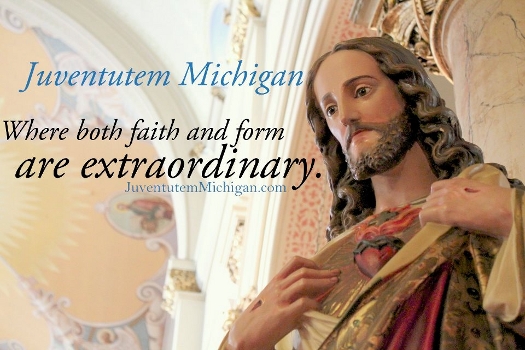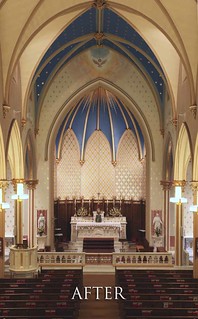
"I will go in unto the Altar of God
To God, Who giveth joy to my youth"
Tridentine Community News (December 16, 2012):
Vatican Establishes New Office for Sacred Architecture and Music
On August 30, 2011, Pope Benedict XVI issued the Motu Proprio Quærit Semper, in which His Holiness transferred certain responsibilities away from the Congregation for Divine Worship, the Vatican department officially charged with administering the Ordinary Form of the Liturgy. He wanted to give the CDW “a fresh impetus to promoting the Sacred Liturgy in the Church...on the basis of the Constitution Sacrosánctum Concílium.” The first major step in that direction was recently taken: Ohio native and current Benedictine monk Abbot Michael Zielinski has been appointed to lead a new office of the CDW which will establish guidelines for sacred architecture and liturgical music.
Abbot Zielinski has studied Gregorian and polyphonic music and the history of art. He was formerly Vice President of the Pontifical Commission for Sacred Architecture and Vice President of the Pontifical Commission for the Cultural Heritage of the Church. In these roles he had the role of advocate for preservation of historically significant treasures of the Church. In its new capacity, the CDW will have a more active role than the former departments in ensuring that new church construction and restoration, along with sacred music, authentically reflect the significance of the Sacred Mysteries.
The Web Site of Duncan Stroik
While we are on the subject of sacred architecture, we draw your attention to the updated web site of Duncan Stroik, Architect. One of the most accomplished designers of traditionally-appointed Catholic churches working today, Stroik has assembled a knockout web site, whose home page changes every few days and displays a full-screen view of one of his firm’s many works-in-process. There is also an impressive Portfolio section in which he shows both new construction projects and church restorations he has done. Below are photos from the restoration he conducted at St. Mary Church in Norwalk, Connecticut.
Artisans like Duncan Stroik give encouraging proof that it is indeed possible to construct, and restore, churches of traditional style, with all of the outfittings to facilitate both the Ordinary and Extraordinary Forms in a hermeneutic of continuity. Yes, Communion Rails and High Pulpits can still be built. After all, we have more advanced construction and design tools at our disposal now than our predecessors had, so why not use them to create the best buildings we can to give God glory?
Stroik has also debuted a new line of liturgical furnishings in partnership with Granda Liturgical Arts. A tabernacle, altar candlesticks and a Crucifix, a sanctuary lamp, and a chalice and ciborium are the initial designs on offer.
For some refreshing views of what is being built in our era, visit www.stroik.com.
The Economist on “A Traditionalist Avant-Garde”
“It’s trendy to be a traditionalist in the Catholic church” – So reads the opening line of an article published in this week’s edition of Britain’s The Economist magazine.
Two readers of this column were among a myriad of people interviewed over the past month by a journalist for this piece. Unusual for a mainstream, secular magazine, the article gave an upbeat and quite accurate assessment of the international surge in popularity of the Extraordinary Form, and in particular its appeal to youth. Juventútem, the London Oratory, and Fr. Z were mentioned, as was traditionalists’ effective use of the internet and blogs to educate and inform the faithful.
The article makes a point that can be difficult for defenders of both the Ordinary and Extraordinary Forms to discuss: Informal worship simply doesn’t appeal to everyone. No intellectual or theological argument need be made; we evangelize both newcomers and existing practicing Catholics by giving them reasons to want to worship in a Catholic church. Casual worship does not address everyone’s spiritual needs; fortunately, Rome has given us alternatives. Even Henry Ford eventually realized that not everyone wanted black cars.
This is not the first time that the media has characterized the Tridentine Mass as trendy. While that term might cause some to wince, it’s just a more colloquial way of pointing out that the Extraordinary Form plays an important role in the New Evangelization.
The article and reader commentary can be found on-line at www.economist.com. Search for “traditionalist”.
Tridentine Masses This Coming Week
- Mon. 12/17 7:00 PM: Low Mass at St. Josaphat (Greater Feria of Advent)
- Tue. 12/18 7:00 PM: Low Mass at Assumption-Windsor (Greater Feria of Advent)




No comments:
Post a Comment